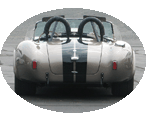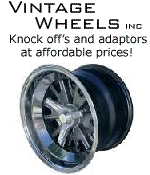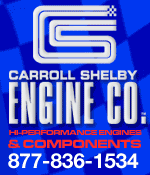 
 Main Menu
Main Menu
|
 Nevada Classics
Nevada Classics
|
 Advertise at CC
Advertise at CC
|
 February 2025
February 2025
|
| S |
M |
T |
W |
T |
F |
S |
| |
|
|
|
|
|
1 |
| 2 |
3 |
4 |
5 |
6 |
7 |
8 |
| 9 |
10 |
11 |
12 |
13 |
14 |
15 |
| 16 |
17 |
18 |
19 |
20 |
21 |
22 |
| 23 |
24 |
25 |
26 |
27 |
28 |
|
|
 CC Advertisers
CC Advertisers
|
|
 12Likes 12Likes

03-11-2017, 06:07 AM
|
 |
CC Member

|
|
|
Join Date: Dec 2015
Location: Clarksville,
TN
Cobra Make, Engine: Scratchbuild, 289 FIA Replica
Posts: 198
|
|

 Not Ranked
Not Ranked
 390 strokers: 431 vs 445
390 strokers: 431 vs 445
Right now, the two most common stroker "kits" are 4.125 or 4.250 cranks, which result with approximately 431 or 445 c.i. displacement.
Knowing that, why would someone choose 431 over 445?
I'm new to stroked engines, so am curious as to what makes the smaller more attractive.
Also, what modifications need to be done to the block? Do the stroker kits just "drop in?"
(I know they don't technically "drop in"; I've built a few SBFs before, but you get my drift.)
|
-
Advertising


03-11-2017, 06:42 AM
|
 |
Half-Ass Member

|
|
|
Join Date: Jun 2005
Cobra Make, Engine: ERA #732, 428FE (447 CID), TKO600, Solid Flat Tappet Cam, Tons of Aluminum
Posts: 22,017
|
|

 Not Ranked
Not Ranked
Quote:
Originally Posted by 120mm

Right now, the two most common stroker "kits" are 4.125 or 4.250 cranks, which result with approximately 431 or 445 c.i. displacement.
|
Among really smart, gifted, and talented FE engine builders, there is a split of opinion as to whether a shorter stroke, which will reduce piston speed, will make an engine "revvier." It has been debated on here, and the FE Forum more than a few times, and both sides are firmly entrenched in their respective positions. FWIW, I opted for the 4.125 SCAT crank for my 428 stroker kit. The longer stroke might make a little more power, but the shorter stroke makes more fun (others will steadfastly disagree).  |

03-11-2017, 06:43 AM
|
|
CC Member

|
|
|
Join Date: Dec 2001
Location: Louisville,
KY
Cobra Make, Engine: I'm Cobra-less!
Posts: 9,417
|
|

 Not Ranked
Not Ranked
I personally don't know why anyone would choose a smaller displacement when all the parts cost the same.
I have sold/used (2) of the 4.125" stroke crankshafts. I have sold/used countless numbers of 4.250" stroke crankshafts.
You get about 1.1-1.2 hp/ci, so that extra 14 cubes will do nothing but add horsepower/torque for the same money.
The 4.125" and 4.250" cranks are drop-in on an FE. The 4.375" is also drop-in, in 99% of situations.
The stroke/rev-ability is a farce. The stroke may be shorter but you're adding a taller and heavier piston on the other end. There is a tremendous amount of variables that go into how quickly an engine will accelerate. Just looking at the stroke is one of the goofiest things you can do.
Last edited by blykins; 03-11-2017 at 06:51 AM..
|

03-11-2017, 07:25 AM
|
 |
CC Member

|
|
|
Join Date: Apr 2009
Location: Little Rock area,
AR
Cobra Make, Engine: ERA Street Roadster #782 with 459 cu in FE KC engine, toploader, 3.31
Posts: 4,527
|
|

 Not Ranked
Not Ranked
I will admit I was a little apprehensive when I selected the 4.25 crank for mine having been mostly a magazine engine builder for the most part and buying into the long strokes don't rev hype. But I have a Lightning PU and a Mustang GT with those long stroke modular motors and they rev like crazy so I went ahead with it. I mated it with a mid-weight Mcleod aluminum flywheel and I swear this hydraulic cam 459 revs like an electric motor nearly. I think a lot of it is in the balance work and care in assembly.
But, I can kind of agree with Patrick's view. If building a mechanical lifter, high compression, high reving motor a 4.125 crank makes Spock-type logical sense. If building a hydraulic lifter, mid-range torque motor, a 4.25 crank would appeal to Spock.
But from my limited experience I'm with Brent.
|

03-11-2017, 07:31 AM
|
|
CC Member

|
|
|
Join Date: Dec 2001
Location: Louisville,
KY
Cobra Make, Engine: I'm Cobra-less!
Posts: 9,417
|
|

 Not Ranked
Not Ranked

A steel Scat 4.250" crank will go to 7500 rpm easily and in a correctly-spec'd engine, will rev like a chainsaw.
If we made the assumption that long stroke crankshafts won't rev, then someone needs to tell Warren Johnson, Pat Musi, and Jon Kaase that they shouldn't be using those 5.500" and 5.750" stroke crankshafts in their Pro Stock engines.
*You need to look at the whole package* before you make gross blanket statements like that. I have seen a 3" stroke 302 truck engine be flat-out lazy and I have seen 5.750" mountain motor pro stock engines go from 1500 rpm to 7500 rpm in an instant.
Before a statement like that is made, you need to look at the weight of the crankshaft, the weight of the reciprocating parts, the weight of the balancer/flywheel and the amount of compression/horsepower/torque that the engine is making.
One of the things that absolutely burns my biscuits is the amount of goofiness that gets passed from forum to forum by armchair engine builders. Stroke vs. acceleration is one of those goofy things.
|

03-11-2017, 07:50 AM
|
 |
Half-Ass Member

|
|
|
Join Date: Jun 2005
Cobra Make, Engine: ERA #732, 428FE (447 CID), TKO600, Solid Flat Tappet Cam, Tons of Aluminum
Posts: 22,017
|
|

 Not Ranked
Not Ranked
I would never bet against blykins having the absolutely correct engineering answer.  But, you have to keep in mind, that you are paying for "the Cobra experience." I have driven more than a couple of cars that are way faster than my Cobra, but I have never driven a car that I think and I feel is faster than my Cobra. I firmly believe that if Brent pulled my engine, replaced my crank with the 4.25", put it back in, and tuned it exactly the same way, that it would have more power and torque when put on the dyno. But I also believe that I would say "yeah, I know what the numbers say, but the other engine just seemed faster...." |

03-11-2017, 07:58 AM
|
|
CC Member

|
|
|
Join Date: Dec 2001
Location: Louisville,
KY
Cobra Make, Engine: I'm Cobra-less!
Posts: 9,417
|
|

 Not Ranked
Not Ranked
Sheep are easily led astray.  |

03-11-2017, 08:02 AM
|
 |
Half-Ass Member

|
|
|
Join Date: Jun 2005
Cobra Make, Engine: ERA #732, 428FE (447 CID), TKO600, Solid Flat Tappet Cam, Tons of Aluminum
Posts: 22,017
|
|

 Not Ranked
Not Ranked
Quote:
Originally Posted by blykins

Sheep are easily led astray.  |
" This above all - to thine own self be true...." Baaaaaaa  |

03-11-2017, 08:06 AM
|
|
CC Member

|
|
|
Join Date: Dec 2001
Location: Louisville,
KY
Cobra Make, Engine: I'm Cobra-less!
Posts: 9,417
|
|

 Not Ranked
Not Ranked
Patrick, if you have driven Cobras known to be faster than yours, but yours "felt" faster, then I would take a long hard look at how you perceive reality.
|

03-11-2017, 08:10 AM
|
 |
Half-Ass Member

|
|
|
Join Date: Jun 2005
Cobra Make, Engine: ERA #732, 428FE (447 CID), TKO600, Solid Flat Tappet Cam, Tons of Aluminum
Posts: 22,017
|
|

 Not Ranked
Not Ranked
Quote:
Originally Posted by blykins

Patrick, if you have driven Cobras known to be faster than yours, but yours "felt" faster, then I would take a long hard look at how you perceive reality.
|
You misread. I said 'other cars,' not 'other Cobras.'  |

03-11-2017, 08:13 AM
|
|
CC Member

|
|
|
Join Date: Dec 2001
Location: Louisville,
KY
Cobra Make, Engine: I'm Cobra-less!
Posts: 9,417
|
|

 Not Ranked
Not Ranked
Oh well, then I'm not so much worried about your perception of reality as I'm worried about your logic.
I'm not interested in going back and forth for 27 pages like you and RK do, so I'm gonna head out to work.
|

03-11-2017, 08:13 AM
|
 |
CC Member

|
|
|
Join Date: Aug 2015
Cobra Make, Engine: All original, with Chevy engine since 1964
Posts: 996
|
|

 Not Ranked
Not Ranked

Quote:
Originally Posted by 120mm

Right now, the two most common stroker "kits" are 4.125 or 4.250 cranks, which result with approximately 431 or 445 c.i. displacement.
Knowing that, why would someone choose 431 over 445?
I'm new to stroked engines, so am curious as to what makes the smaller more attractive.
|
My (amateur engine builder) opinion is right in line with Blykin's (pro engine builder)'s opinions..,
and I also agree with Patrick that with a street engine, the "feel" and the sensation that an engine provides you is just as important as the raw bench-racing numbers, so focus on the shape of the HP and torque curves that will maximize power in the RPM ranges that your car will actually spend time operating in, moreso than worrying about peak numbers.
As to why someone might purposefully choose a same-priced, but smaller stroke crank... Mainly that choice is made when building an engine for a racing class that has specific cubic inch limitations, or maybe has cylinder head limitations (some classes require factory, unmodified head castings that reach a point where they just stop flowing any better, regardless of how many more CFM you try to pump through them)
but for a hobby-car engine, where cost is a concern- absolutely- take the free cubes wherever you can get them....
Nothing creates power easier than basic air-pumping capacity.
__________________
- Robert
Last edited by moore_rb; 03-11-2017 at 08:16 AM..
|

03-11-2017, 08:20 AM
|
 |
Half-Ass Member

|
|
|
Join Date: Jun 2005
Cobra Make, Engine: ERA #732, 428FE (447 CID), TKO600, Solid Flat Tappet Cam, Tons of Aluminum
Posts: 22,017
|
|

 Not Ranked
Not Ranked
Quote:
Originally Posted by blykins

Oh well, then I'm not so much worried about your perception of reality as I'm worried about your logic.
I'm not interested in going back and forth for 27 pages like you and RK do, so I'm gonna head out to work.
|
In life, when you are assessing the efficacy of a "staple," reality is more important than perception. However, when assessing a "luxury," perception is more important than reality.  For most of us, a Cobra is a luxury.  |

03-11-2017, 08:23 AM
|
 |
CC Member

|
|
|
Join Date: Aug 2015
Cobra Make, Engine: All original, with Chevy engine since 1964
Posts: 996
|
|

 Not Ranked
Not Ranked
Quote:
Originally Posted by blykins

I'm not interested in going back and forth for 27 pages like you and RK do, so I'm gonna head out to work.
|
I just got off the phone with my bookie in Vegas, trying to get an over/under on the likelihood that I would be unsubscribed from this thread by the end of the day today.... 
__________________
- Robert
|

03-11-2017, 08:30 AM
|
 |
Half-Ass Member

|
|
|
Join Date: Jun 2005
Cobra Make, Engine: ERA #732, 428FE (447 CID), TKO600, Solid Flat Tappet Cam, Tons of Aluminum
Posts: 22,017
|
|

 Not Ranked
Not Ranked
Quote:
Originally Posted by moore_rb

I just got off the phone with my bookie in Vegas, trying to get an over/under on the likelihood that I would be unsubscribed from this thread by the end of the day today....  |
Well, in that case you can tune in to Meltzer's rebuild of his 4160. I think we've got that scheduled for later today.  |

03-11-2017, 10:27 AM
|
|
CC Member

|
|
|
Join Date: May 2006
Location: St. Louisville,
Oh
Cobra Make, Engine: A&C 67 427 cobra SB
Posts: 2,445
|
|

 Not Ranked
Not Ranked

Well I spent an hour writing a masterpiece on the subject - from my perspective, and I forgot to save it in a paste buffer before clicking reply. When it forced me to log in a second time, it all PHUCKING DISAPPEARED! Why this site logs you out after a few minutes I don't know, but it is annoying.
If the rotating assembly can spin all day at 7500 rpm and not fail, then who cares what the stroke is? It works. It will not be the limiting factor, up to the 7500 rpm.
If the head and cam combination can be made to allow the displacement to fill the cylinders to get the peak Hp at the desired rpm, then the stroke was not wasted. In any bore size and given head, there is a point at which more stroke does not increase Hp because you just cannot get any more air into the engine no matter how much faster you turn it. That point is typically well past the length of the cylinder block, with good heads.
The rod angle or rod length to stroke length is a factor. The worse the rod angle the higher the side loads and worse it is for wear and longevity of the engine. Often times the rod ratio is better in a stroker kit than other factory engines that have a great longevity track record. Of the stroker combinations I have looked at in detail, I have yet to find a rod ratio that concerned me.
Valve train control is the most likely problem to limit an engine. Bigger valves, long push rods, and heavy rockers are the enemy of a high rpm valve train. Increasing the stroke in a given engine makes no change to any of these components. They will limit the rpm more than likely, and stroke had nothing to do with it.
So this sums up how high the engine can rev. Strokers can rev very high.
As for how quickly can an engine accelerate from 1000 rpm to 6000 rpm it is simple. Linear motion it is:
Acceleration = Force / Mass
For angular acceleration:
Acceleration = Torque / Moment of Inertia
If increasing the stroke increases the Torque, that was a positive change in the right direction.
Moment of inertia takes into account the mass and the distance from the pivot point. Remember the stroke increase does not move the piston at top dead center. It moves in further down at BDC. Often strokers have lighter pistons and rods to keep the rod bolts from stretching at high rpms. The crankshaft may get heavier to balance the rod journals moving out, but it may get lighter. Sometimes we go to smaller diameter rod journals and hollow out the journal. So in some cases the moment of inertia could go down. Also a positive move in the right direction, but maybe not.
Then we have to look at the fly wheel. When you look at a monster cast iron or steel flywheel, it has to be a huge part of the Moment of Inertia. You change to an aluminum fly wheel, and I am quite sure the total Moment of Inertia has to be less than the factory stroke and flywheel. By the way the clutch and pressure plate matter too.
Thus a stroker can easily be made to rev as quick or quicker than the shorter stroke. When we are talking about an 1/8" it just doesn't matter.
Last edited by olddog; 03-11-2017 at 11:05 AM..
Reason: word smithing
|

03-11-2017, 10:30 AM
|
 |
Half-Ass Member

|
|
|
Join Date: Jun 2005
Cobra Make, Engine: ERA #732, 428FE (447 CID), TKO600, Solid Flat Tappet Cam, Tons of Aluminum
Posts: 22,017
|
|

 Not Ranked
Not Ranked
Quote:
Originally Posted by olddog

...
When we are talking about an 1/8" it just doesn't matter.
|
Well, in that case I'll just chalk you up as agreeing with me.  |

03-11-2017, 10:52 AM
|
|
CC Member

|
|
|
Join Date: May 2006
Location: St. Louisville,
Oh
Cobra Make, Engine: A&C 67 427 cobra SB
Posts: 2,445
|
|

 Not Ranked
Not Ranked
Quote:
Originally Posted by patrickt

Well, in that case I'll just chalk you up as agreeing with me.  |
Yes Patrick. Giving up 15 Hp because it makes you feel like you could rev the engine higher, even though in reality it cannot, does not matter one iota for a non race car. If it gives you a false warm fuzzy, it was worth every Hp given up, because it is a pleasure car, and it pleased you.
Let's face it, you could easily make up the 15 hp by getting cooler air to the engine or reducing exhaust back pressure. Since you cannot hook the power you have to the ground it probably still doesn't matter. Most of what we do does not matter, but there is no fun in thinking that way. |

03-11-2017, 12:59 PM
|
 |
CC Member

|
|
|
Join Date: Apr 2008
Location: Melbourne,
Vic
Cobra Make, Engine: Some polish thing... With some old engine
Posts: 2,286
|
|

 Not Ranked
Not Ranked
Go the 445.
There's no reason not to.  |

03-11-2017, 01:01 PM
|
 |
Half-Ass Member

|
|
|
Join Date: Jun 2005
Cobra Make, Engine: ERA #732, 428FE (447 CID), TKO600, Solid Flat Tappet Cam, Tons of Aluminum
Posts: 22,017
|
|

 Not Ranked
Not Ranked
Quote:
Originally Posted by olddog

Since you cannot hook the power you have to the ground it probably still doesn't matter. Most of what we do does not matter, but there is no fun in thinking that way.
|
It's not even that close any more.... I don't think I even opened the secondaries more than maybe twice last year.  |
 Posting Rules
Posting Rules
|
You may not post new threads
You may not post replies
You may not post attachments
You may not edit your posts
HTML code is Off
|
|
|
All times are GMT -7. The time now is 11:37 PM.
|













 12Likes
12Likes







 But, you have to keep in mind, that you are paying for "the Cobra experience." I have driven more than a couple of cars that are way faster than my Cobra, but I have never driven a car that I think and I feel is faster than my Cobra. I firmly believe that if Brent pulled my engine, replaced my crank with the 4.25", put it back in, and tuned it exactly the same way, that it would have more power and torque when put on the dyno. But I also believe that I would say "yeah, I know what the numbers say, but the other engine just seemed faster...."
But, you have to keep in mind, that you are paying for "the Cobra experience." I have driven more than a couple of cars that are way faster than my Cobra, but I have never driven a car that I think and I feel is faster than my Cobra. I firmly believe that if Brent pulled my engine, replaced my crank with the 4.25", put it back in, and tuned it exactly the same way, that it would have more power and torque when put on the dyno. But I also believe that I would say "yeah, I know what the numbers say, but the other engine just seemed faster...."




 Linear Mode
Linear Mode



